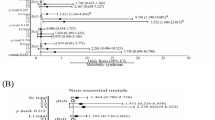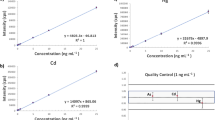Abstract
Body stores of lead, cadmium, and mercury are determined by the levels in the circulation, and their levels in blood may be related to hemoglobin levels and their absorption by soft tissue and bone. We investigated the association of body fat percentage, hemoglobin levels, and nutrient intakes with the blood concentrations of lead, cadmium, and mercury in a Korean adult population. This study was based on data from the 2008–2010 Korean National Health and Nutritional Examination Survey (n = 4,522, aged ≥20 years), which examined nutritional, biochemical, and health-related parameters. A multiple regression analysis after controlling for covariates of age, body mass index, residence area, education level, smoking and drinking status, and bone mineral density for men, with menopausal status added for women in addition to covariates for men indicated that blood lead and mercury levels were negatively associated with body fat percentage only in men, and blood lead, cadmium, and mercury levels were positively related to hemoglobin levels in both genders. Additionally, blood lead levels were negatively associated with fat and carbohydrate intake in both men and women but blood mercury levels were only in men, but not women. Sodium intake was a positive predictor of blood lead levels in both genders but was a positive predictor of blood cadmium levels only in men. In conclusion, body fat percentage and hemoglobin levels need to be recognized as confounding factors when considering blood levels of lead, cadmium and mercury as biomarkers for their exposure. Fat, carbohydrates and sodium intakes are also associated with heavy metal levels in the circulation.
Similar content being viewed by others
References
Kishida K, Funahashi T, Matsuzawa Y, Shimomura I (2012) Visceral adiposity as a target for the management of the metabolic syndrome. Ann Med 44:233–241
Misra A, Singhal N, Khurana L (2010) Obesity, the metabolic syndrome, and type 2 diabetes in developing countries: role of dietary fats and oils. J Am Coll Nutr 29:289S–301S
Lee BK, Kim Y (2012) Blood cadmium, mercury, and lead and metabolic syndrome in South Korea: 2005–2010 Korean National Health and Nutrition Examination Survey. Am J Ind Med. doi:10.1002/ajim.22107
Chen YW, Yang CY, Huang CF, Hung DZ, Leung YM, Liu SH (2009) Heavy metals, islet function and diabetes development. Islets 1:169–176
Gallagher CM, Meliker JR (2010) Blood and urine cadmium, blood pressure, and hypertension: a systematic review and meta-analysis. Environ Health Perspect 118:1676–1684
Kim NS, Lee BK (2011) National estimates of blood lead, cadmium, and mercury levels in the Korean general adult population. Int Arch Occup Environ Health 84:53–63
Mahaffey KR, Clickner RP, Bodurow CC (2004) Blood organic mercury and dietary mercury intake: National Health and Nutrition Examination Survey, 1999 and 2000. Environ Health Perspect 112:562–570
Madeddu R, Solinas G, Forte G et al (2011) Diet and nutrients are contributing factors that influence blood cadmium levels. Nutr Res 31:691–697
Akesson A, Berglund M, Schütz A, Bjellerup P, Bremme K, Vahter M (2002) Cadmium exposure in pregnancy and lactation in relation to iron status. Am J Public Health 92:284–287
Meltzer HM, Brantsaeter AL, Borch-Iohnsen B et al (2010) Low iron stores are related to higher blood concentrations of manganese, cobalt and cadmium in non-smoking, Norwegian women in the HUNT 2 study. Environ Res 110:497–504
Kim H, Lee HJ, Hwang JY et al (2010) Blood cadmium concentrations of male cigarette smokers are inversely associated with fruit consumption. J Nutr 140:1133–1138
Swiergosz-Kowalewska R (2001) Cadmium distribution and toxicity in tissues of small rodents. Microsc Res Technol 55:208–222
Boening DW (2000) Ecological effects, transport, and fate of mercury: a general review. Chemosphere 40:1335–1351
Aaseth J, Boivin G, Andersen O (2012) Osteoporosis and trace elements—an overview. J Trace Elem Med Biol 26:149–152
Qin YY, Leung CKM, Leung AOW, Wu SC, Zheng JS, Wong MH (2010) Persistent organic pollutants and heavy metals in adipose tissues of patients with uterine leiomyomas and the association of these pollutants with seafood diet, BMI, and age. Environ Sci Pollut Res 17:229–240
Xuehui C (2007) Accumulation of heavy metals and organochlorine pesticides in human milk and adipose tissues, and its health concerns. Master’s thesis, Hong Kong Baptist University
Engström A, Michaëlsson K, Vahter M, Julin B, Wolk A, Åkesson A (2012) Associations between dietary cadmium exposure and bone mineral density and risk of osteoporosis and fractures among women. Bone 50:1372–1378
Rothney MP, Martin FP, Xia Y, Beaumont M, Davis C, Ergun D, Fay L, Ginty F, Kochhar S, Wacker W, Rezzi S (2012) Precision of GE lunar iDXA for the measurement of total and regional body composition in nonobese adults. J Clin Densitom 15:399–404
Min KB, Lee KJ, Park JB, Min JY (2012) Lead and cadmium levels and balance and vestibular dysfunction among adult participants in the National Health and Nutrition Examination Survey (NHANES) 1999–2004. Environ Health Perspect 120:413–417
Mozaffarian D, Shi P, Morris JS et al (2012) Mercury exposure and risk of hypertension in US men and women in 2 prospective cohorts. Hypertension 60:645–652
Agency for Toxic Substances and Disease Registry (1999) Toxicological profile for lead. US Department of Health and Human Services, Public Health Service, Atlanta
Al-Rmalli SW, Jenkins RO, Haris PI (2012) Dietary intake of cadmium from Bangladeshi foods. J Food Sci 77:T26–T33
Lee BK, Park S (2012) Strong positive associations between seafood, vegetables, and alcohol with blood mercury and urinary arsenic levels in the Korean adult population. Arch Environ Contam Toxicol 2012 Sep 21 [Epub ahead of print]
Sabolić I, Breljak D, Skarica M, Herak-Kramberger CM (2010) Role of metallothionein in cadmium traffic and toxicity in kidneys and other mammalian organs. Biometals 23:897–926
Park S, Lee BK (2012) Inverse relationship between fat intake and blood lead levels in the Korean adult population in the KNHANES 2007–2009. Sci Total Environ 430:161–166
Cotte M, Checroun E, Susini J et al (2006) Kinetics of oil saponification by lead salts in ancient preparations of pharmaceutical lead plasters and painting lead mediums. Talanta 70:1136–1142
Barltrop D, Khoo HE (1975) The influence of nutritional factors on lead absorption. Postgrad Med J 51:795–800
Julin B, Vahter M, Amzal B et al (2011) Relation between dietary cadmium intake and biomarkers of cadmium exposure in premenopausal women accounting for body iron stores. Environ Health 10:105
Barany E, Bergdahl IA, Bratteby LE et al (2005) Iron status influences trace element levels in human blood and serum. Environ Res 98:215–223
Ali AM (1999) Determination of trace metal ions in common salt by stripping voltammetry. J AOAC Int 82:1413–1418
Soylak M, Peker DS, Turkoglu O (2008) Heavy metal contents of refined and unrefined table salts from Turkey, Egypt and Greece. Environ Monit Assess 143:267–272
Hu GH, Huang SH, Chen H, Wang F (2010) Binding of four heavy metals to hemicelluloses from rice bran. Food Res Int 43:203–206
Sharma RK, Agrawal M, Marshall FM (2008) Heavy metal (Cu, Zn, Cd and Pb) contamination of vegetables in urban India: a case study in Varanasi. Environ Pollut 154:254–263
Popovic M, McNeill FE, Chettle DR, Webber CE, Lee CV, Kaye WE (2005) Impact of occupational exposure on lead levels in women. Environ Health Perspect 113:478–484
Vahter M, Akesson A, Lidén C, Ceccatelli S, Berglund M (2007) Gender differences in the disposition and toxicity of metals. Environ Res 104:85–95
Gerhard I, Waibel S, Daniel V, Runnebaum B (1998) Impact of heavy metals on hormonal and immunological factors in women with repeated miscarriages. Hum Reprod Updat 4:301–309
Nampoothiri LP, Gupta S (2006) Simultaneous effect of lead and cadmium on granulosa cells: a cellular model for ovarian toxicity. Reprod Toxicol 21:179–185
Hense HW, Filipiak B, Novak L, Stoeppler M (1992) Nonoccupational determinants of blood lead concentrations in a general population. Int J Epidemiol 21:753–762
Grandjean P, Hollnagel H, Hedegaard L, Christensen JM, Larsen S (1989) Blood lead–blood pressure relations: alcohol intake and hemoglobin as confounders. Am J Epidemiol 129:732–739
De Silva PE (1984) Blood lead levels and the haematocrit correction. Ann Occup Hyg 28:417–428
Conflicts of interest
The authors declare that there have no conflicts of interest.
Authorship responsibilities
B.K. Lee conducted statistical analysis and review of the manuscript and S. Park prepared the manuscript; both authors participated in experimental design.
Author information
Authors and Affiliations
Corresponding author
Rights and permissions
About this article
Cite this article
Park, S., Lee, BK. Body Fat Percentage and Hemoglobin Levels Are Related to Blood Lead, Cadmium, and Mercury Concentrations in a Korean Adult Population (KNHANES 2008–2010). Biol Trace Elem Res 151, 315–323 (2013). https://doi.org/10.1007/s12011-012-9566-7
Received:
Accepted:
Published:
Issue Date:
DOI: https://doi.org/10.1007/s12011-012-9566-7




